
Promoting collaborative, pro-poor agricultural innovation
2003-2024

LUNGELO BUTHELEZII
Field worker
NQOBILE MBOKAZII
Field worker
NOXOLO SIBIYA
Field worker
MAZWI DLAMINI
Area manager, Deputy
director
TEMA MATHEBULA
Area manager
SARIKA
RAAMSEWAK
Finance
Manager
ERNA KRUGER
Director
HLENGIWE
HLONGWANE
Lead field worker
BETTY
MAIMELA
Area manager
S’PHUME MBHELE
Field worker
NQE
DLAMINI
Microfinance
support
THABANI MADONDO
Field worker
MDF organisational profile

Vision
Tosupporttheharmonious living of people in their
natural, social and economic environments in a way that
supports and strengthens both the people and their
environment.
Toassisttherural poorto better their lives, to
diversifytheir livelihoods and to face their challenges
with resilience.
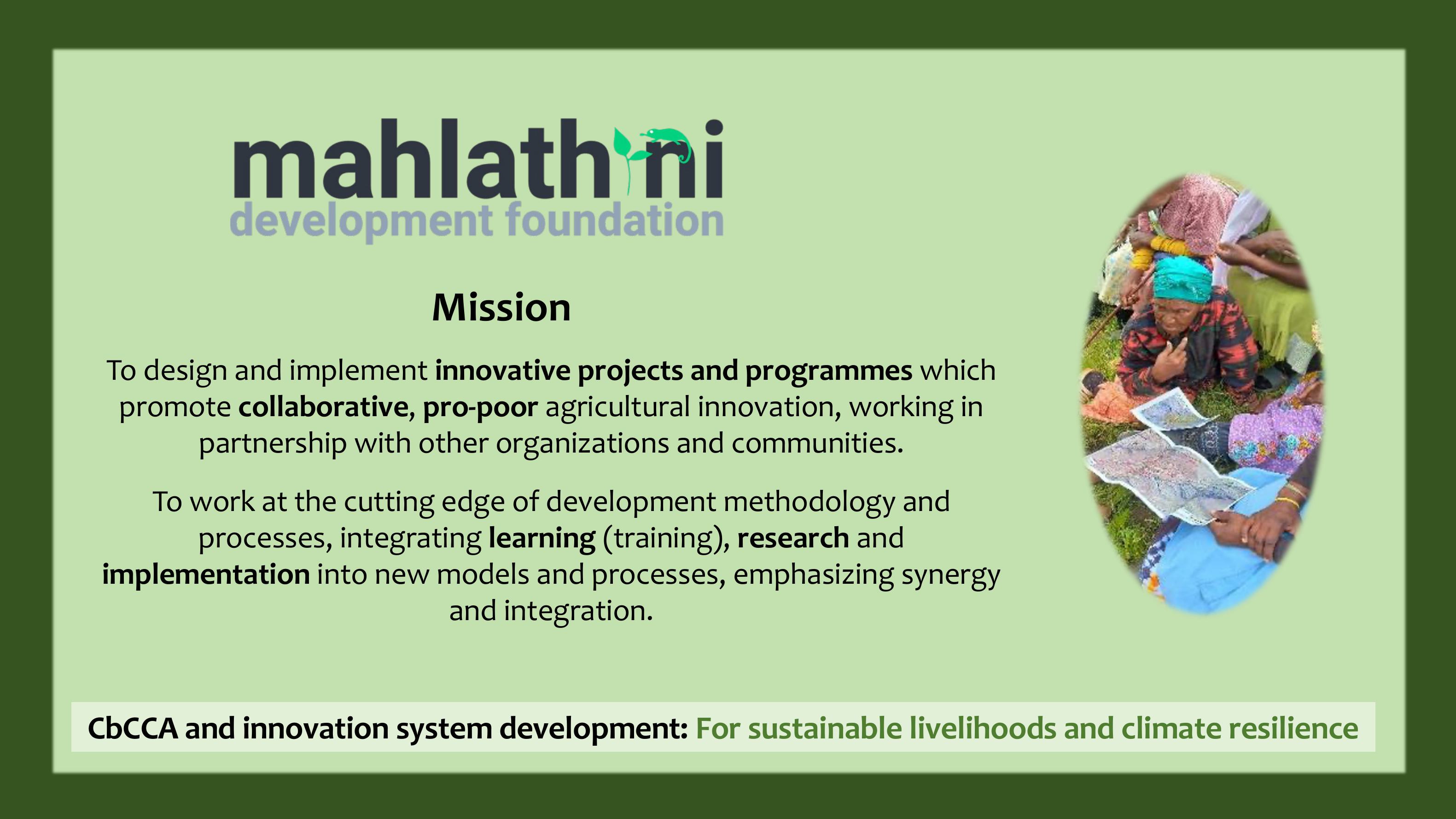
Todesignandimplementinnovative projects and programmes which
promote collaborative, pro-pooragricultural innovation, working in
partnership with other organizations and communities.
CbCCAand innovationsystem development: For sustainable livelihoods and climate resilience
Toworkatthecuttingedgeofdevelopmentmethodologyand
processes, integrating learning(training), researchand
implementationinto new models and processes, emphasizing synergy
and integration.
Mission

Funders Partners

The smallholder farming system
Smallholder
farming
system
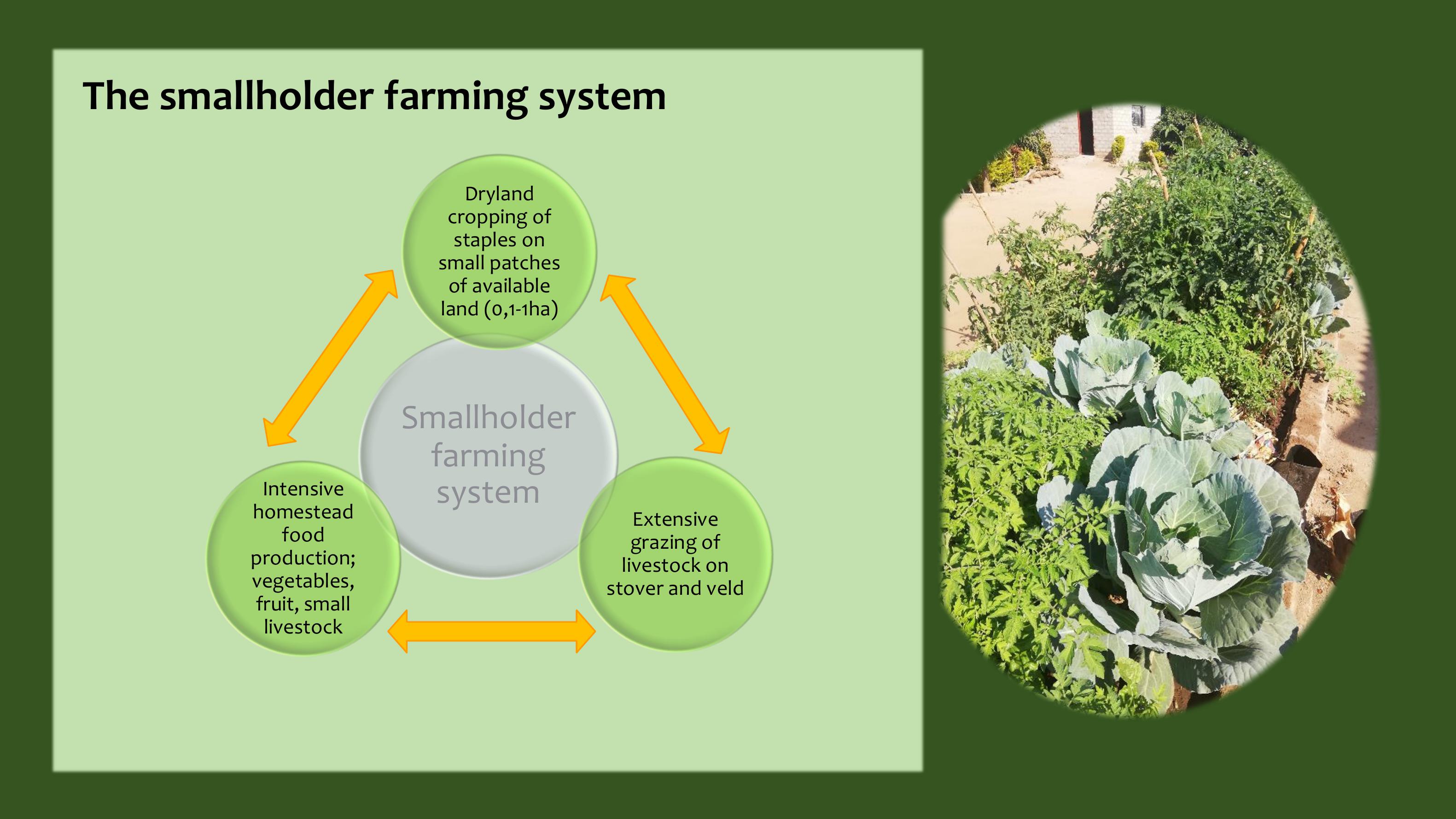
The smallholder farming system
Smallholder
farming
system
Dryland
cropping of
staples on
small patches
of available
land (0,1-1ha)
Extensive
grazing of
livestock on
stover and veld
Intensive
homestead
food
production;
vegetables,
fruit, small
livestock

Cover
crops,
non
staples
OM
and soil
fertility
Little to
no soil
cover
The smallholder farming system
Feed
biomass
mulch
Manure
mulch
Fodder
manure
stover
Smallholder
farming
system
Image
Dryland
cropping of
staples on
small patches
of available
land (0,1-1ha)
Extensive
grazing of
livestock on
stover and veld
Intensive
homestead
food
production;
vegetables,
fruit, small
livestock
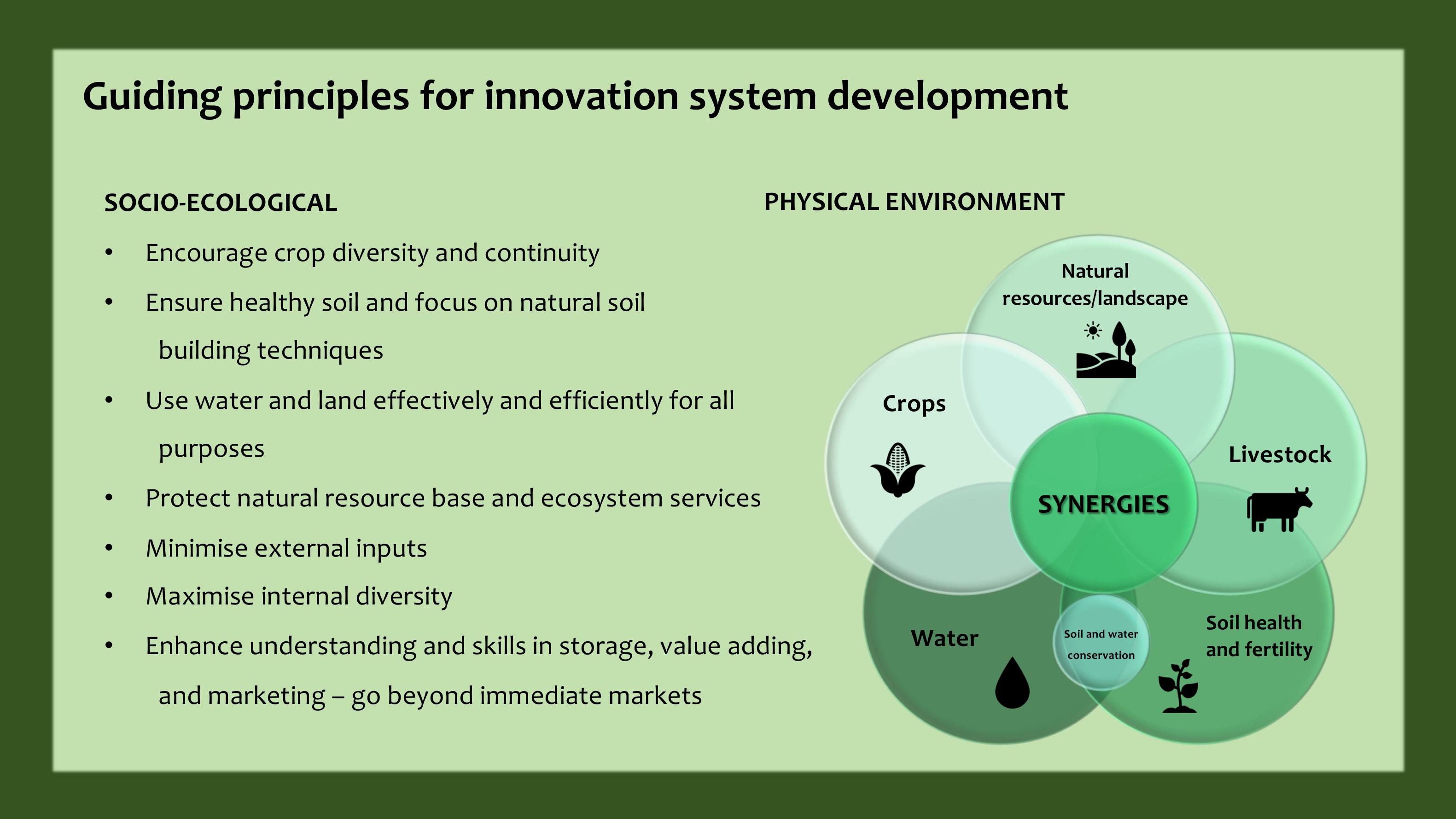
Guiding principles for innovation system development
SOCIO-ECOLOGICAL
•Encourage crop diversity and continuity
•Ensure healthy soil and focus on natural soil
building techniques
•Use water and land effectively and efficiently for all
purposes
•Protect natural resource base and ecosystem services
•Minimise external inputs
•Maximise internal diversity
•Enhance understanding and skills in storage, value adding,
and marketing – go beyond immediate markets
PHYSICAL ENVIRONMENT
Crops
Natural
resources/landscape
Livestock
Water Soil health
and fertility
SYNERGIES
Soil and water
conservation

Guiding principles for innovation system development
SOCIO-ECONOMIC
•Focus on local solutions and economies
•Build on community-based criteria, indicators and priorities
•Generate transitional strategies
•Assess costs and benefits
•Link national and local planning mechanisms
•Strengthen local networks
•Promote values other than financial values
•Prioritize locally appropriate actions
•Worktogether,learntogether,plantogether

•Community owned local water access: Water committees,
spring protection, water reticulation, pipes and tanks at
homestead level
•Soil and water conservation: village-based learning groups
in Climate Change Adaptation undertake resource
conservation activities
ACTIVITY: Water and Natural Resource Management for sustainable and
productive use of land and water
48 villages in EC, KZN
and Limpopo
850 small holder
farmers
3500
beneficiaries

ACTIVITY: Climate Resilient Agriculture and innovation system
development for sustainable and productive use of land and water
•Conservation/ Regenerative Agriculture: (LEI) Quantitative research support to the Smallholder Farmer
Innovation Programme; intercropping, crop rotation, cover crops, fodder production
•Livestock integration: Winter fodder supplementation, hay baling, conservation agreements, local livestock
auctions
•Intensive homestead food production: Agroecology; tunnels, trench beds, crop diversification, mulching,
greywater management, fruit production
•Village savings and loan associations: Village based savings groups for savings and small loans for productive
activities
•Local marketing and food systems: Monthly produce market stalls organised per village, exploration of further
marketing options, small
mills for maize48 villages in EC, KZN
and Limpopo
850 small holder
farmers
3500
beneficiaries
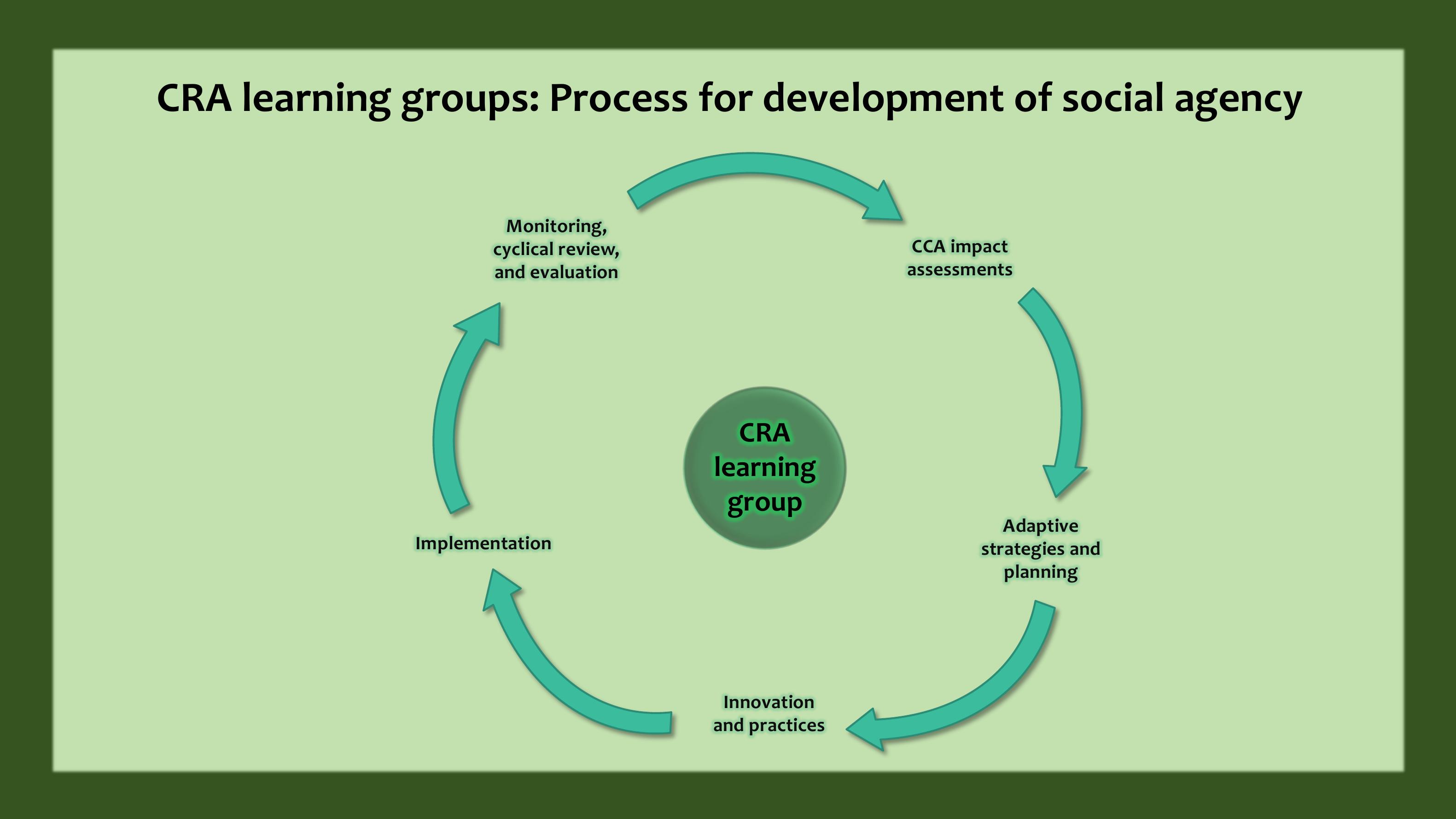
CRA learning groups: Process for development of social agency
CRA
learning
group
Monitoring,
cyclical review,
and evaluation
CCA impact
assessments
Implementation
Innovation
and practices
Adaptive
strategies and
planning
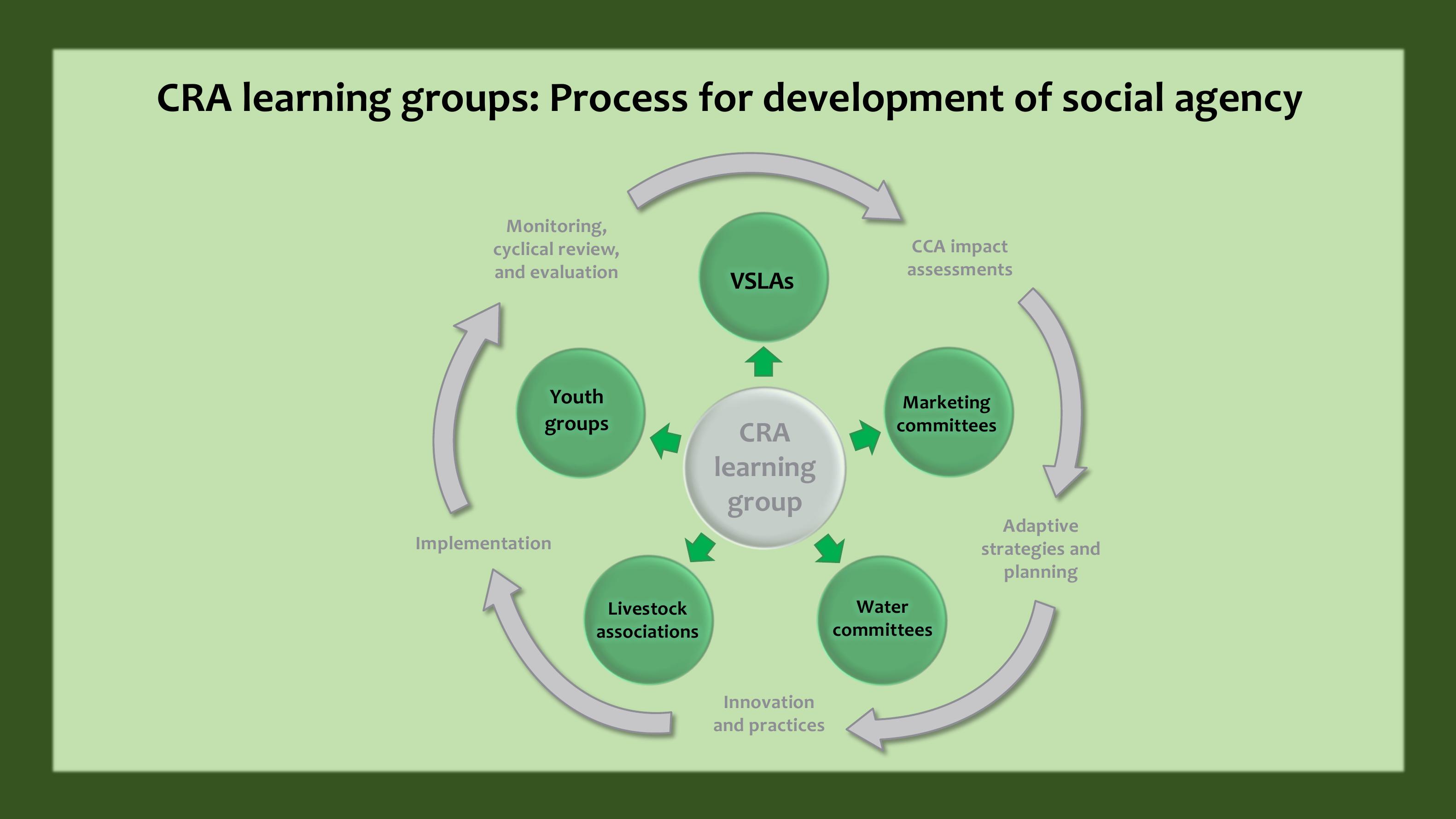
CRA learning groups: Process for development of social agency
CRA
learning
group
Livestock
associations
VSLAs
Youth
groups
Monitoring,
cyclical review,
and evaluation
Marketing
committees
Water
committees
CCA impact
assessments
Implementation
Innovation
and practices
Adaptive
strategies and
planning
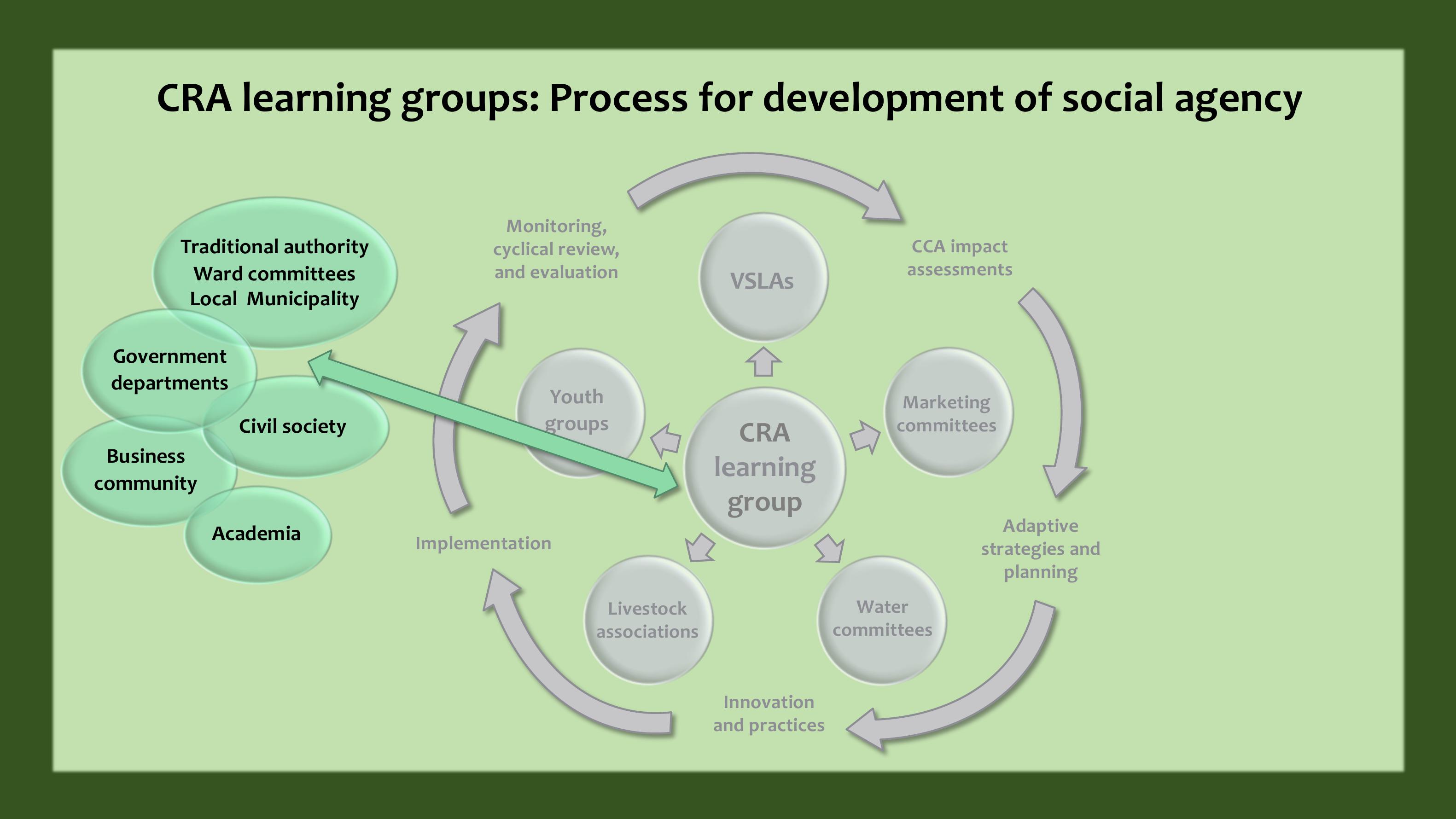
CRA learning groups: Process for development of social agency
CRA
learning
group
Livestock
associations
VSLAs
Youth
groups
Monitoring,
cyclical review,
and evaluation
Traditionalauthority
Ward committees
Local Municipality
Marketing
committees
Water
committees
Government
departments
Civil society
Academia
Business
community
CCA impact
assessments
Implementation
Innovation
and practices
Adaptive
strategies and
planning

CRA learning groups: Process for development of social agency
CRA
learning
group
Livestock
associations
VSLAs
Youth
groups
Monitoring,
cyclical review,
and evaluation
Traditionalauthority
Ward committees
Local Municipality
Marketing
committees
Water
committees
Government
departments
Civil society
Academia
Business
community
Innovation platforms –
clusters of LGs
Associations and
organisations
Multistakeholder
platforms
CCA impact
assessments
Implementation
Innovation
and practices
Adaptive
strategies and
planning

Putting the bits together for locally led adaptation
Identify options and implement
Build improved systems and social agency
Collect and analyse information
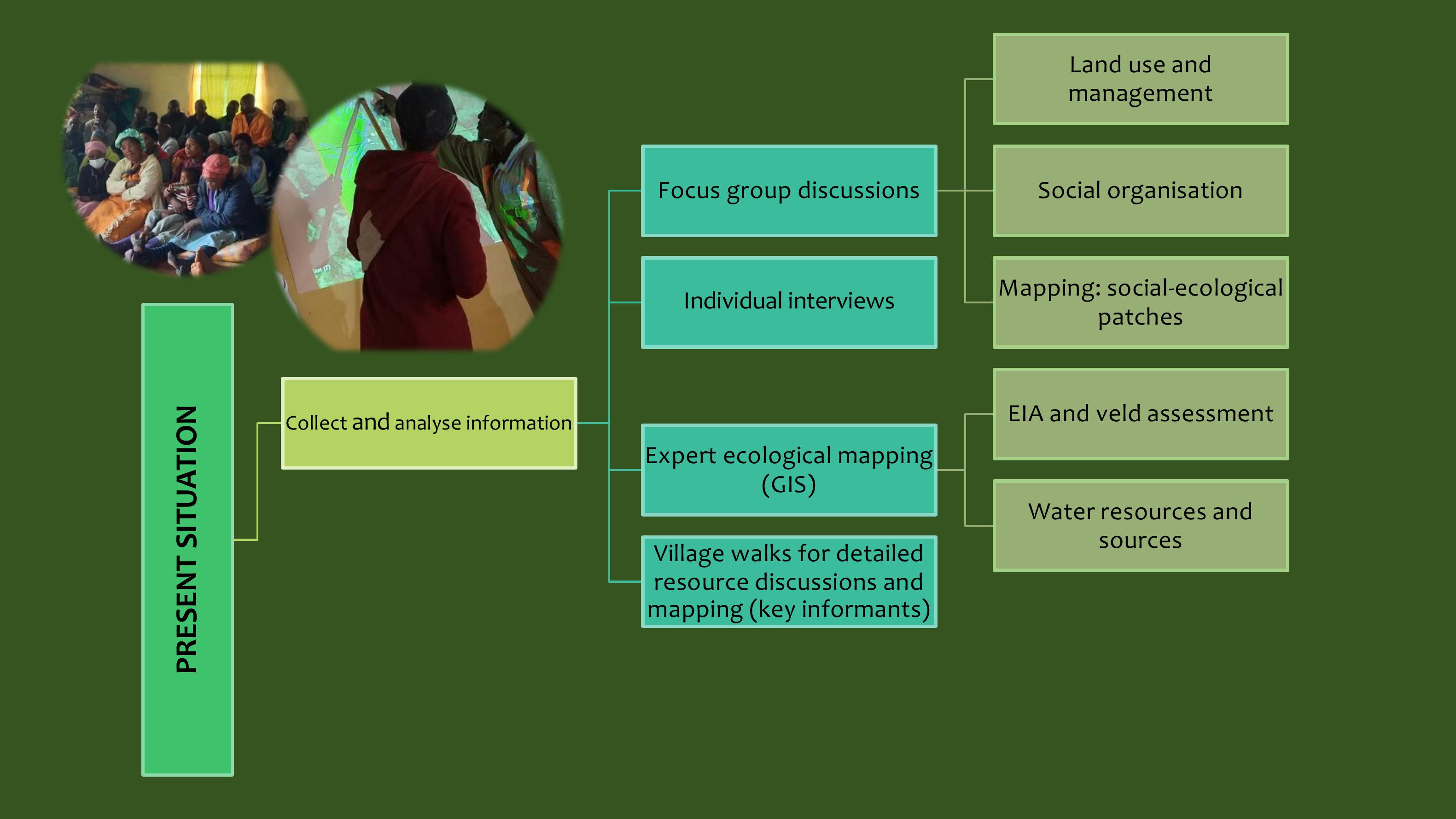
Collectandanalyse information
Focus group discussions
Land use and
management
Social organisation
Mapping: social-ecological
patches
Individual interviews
Expert ecological mapping
(GIS)
EIA and veld assessment
Water resources and
sources
Village walks for detailed
resource discussions and
mapping (key informants)
PRESENT SITUATION
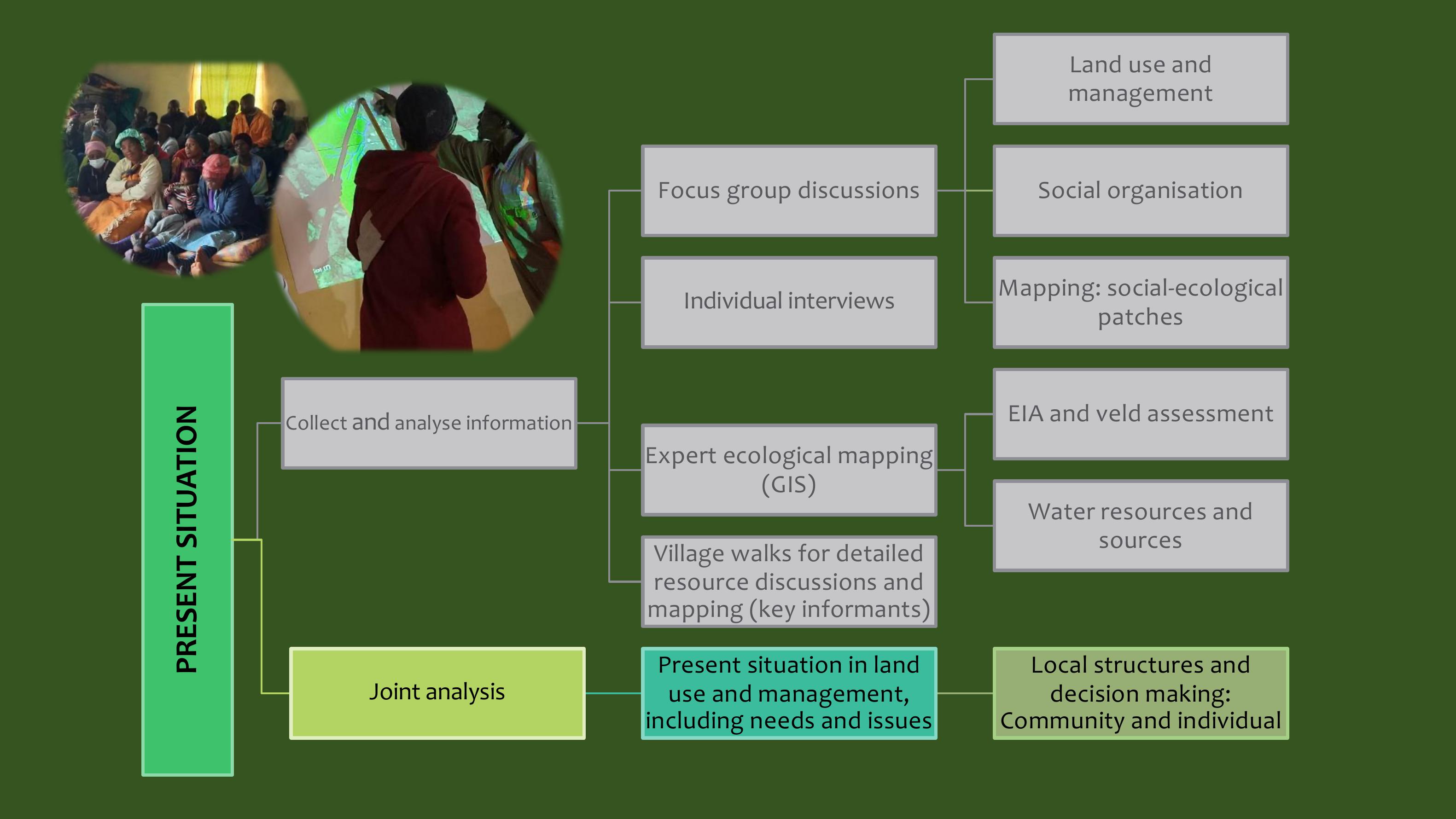
PRESENT SITUATION
Collectandanalyse information
Focus group discussions
Land use and
management
Social organisation
Mapping: social-ecological
patches
Individual interviews
Expert ecological mapping
(GIS)
EIA and veld assessment
Water resources and
sources
Village walks for detailed
resource discussions and
mapping (key informants)
Joint analysis
Present situation in land
use and management,
including needs and issues
Local structures and
decision making:
Communityand individual

Co-learning and co-creation
Thematic workshops:
Climate change, resources
issues
Choose thematic focus
areas to work on: e.g.
water access, resource
conservation, wetland
rehabilitation etc
Further engagement with
stakeholders for expanded
implementation options
around water and resource
management
Climate change workshops:
impact, adaptive strategies,
prioritization of measures
practices
Experimentation with new
innovations and practices
IDENTIFY OPTIONS AND
IMPLEMENT

IDENTIFY OPTIONS AND
IMPLEMENT
Co-learning and co-creation
Thematic workshops:
Climate change, resources
issues
Choose thematic focus
areas to work on: e.g.
water access, resource
conservation, wetland
rehabilitation etc
Further engagement with
stakeholders for expanded
implementation options
around water and resource
management
Climate change workshops:
impact, adaptive strategies,
prioritization of measures
practices
Experimentation with new
innovations and practices
Action
Completed social-
ecological maps with
impact of human
interventions
Set up village- based
learning groups with list of
prioritized practices
CRA learning and
implementation
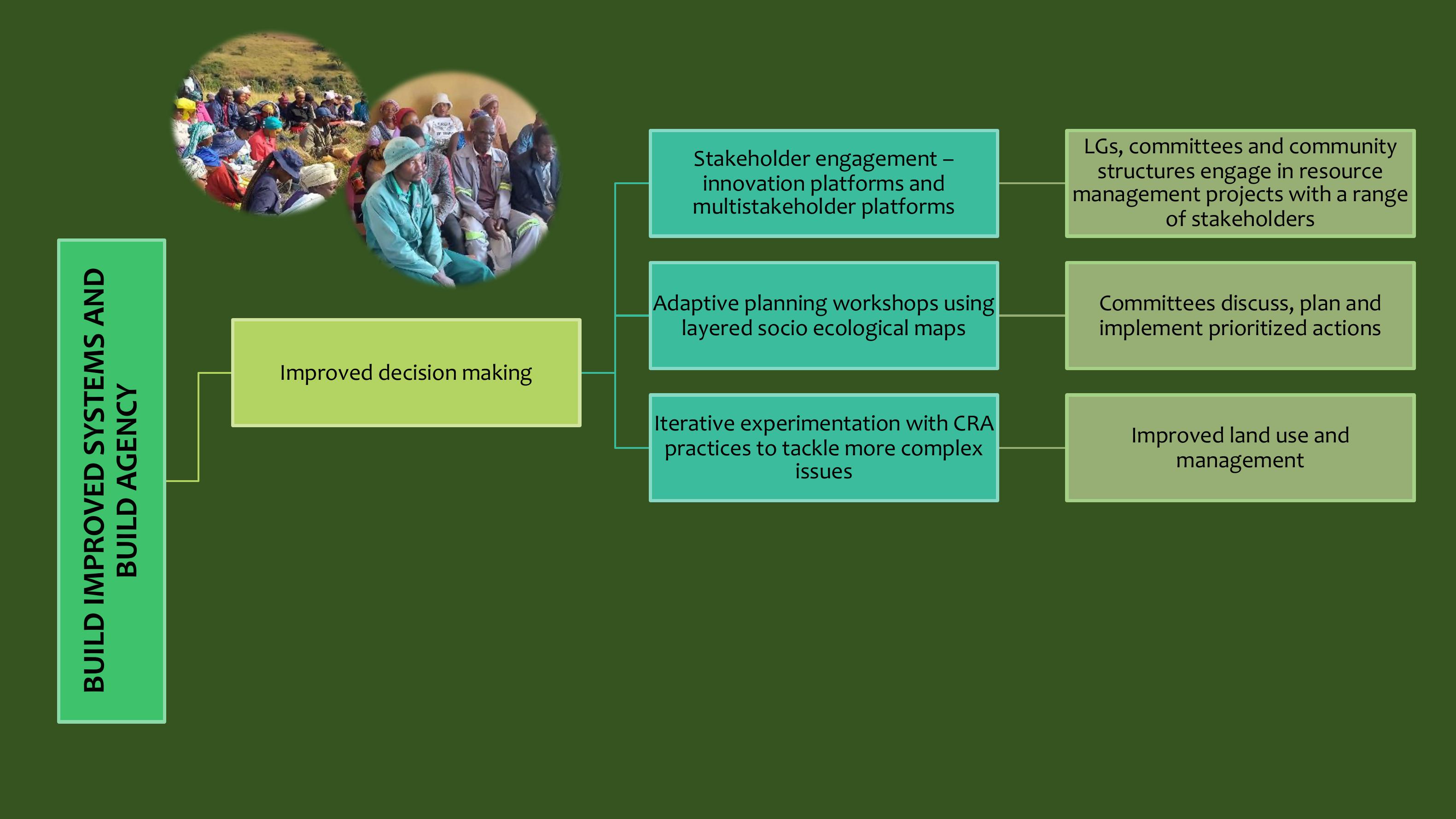
Improved decision making
Stakeholder engagement –
innovation platforms and
multistakeholder platforms
LGs, committees and community
structures engage in resource
management projects with a range
of stakeholders
Adaptive planning workshops using
layered socio ecological maps
Committees discuss, plan and
implement prioritized actions
Iterative experimentation with CRA
practices to tackle more complex
issues
Improved land use and
management
BUILD IMPROVED SYSTEMS AND
BUILD AGENCY
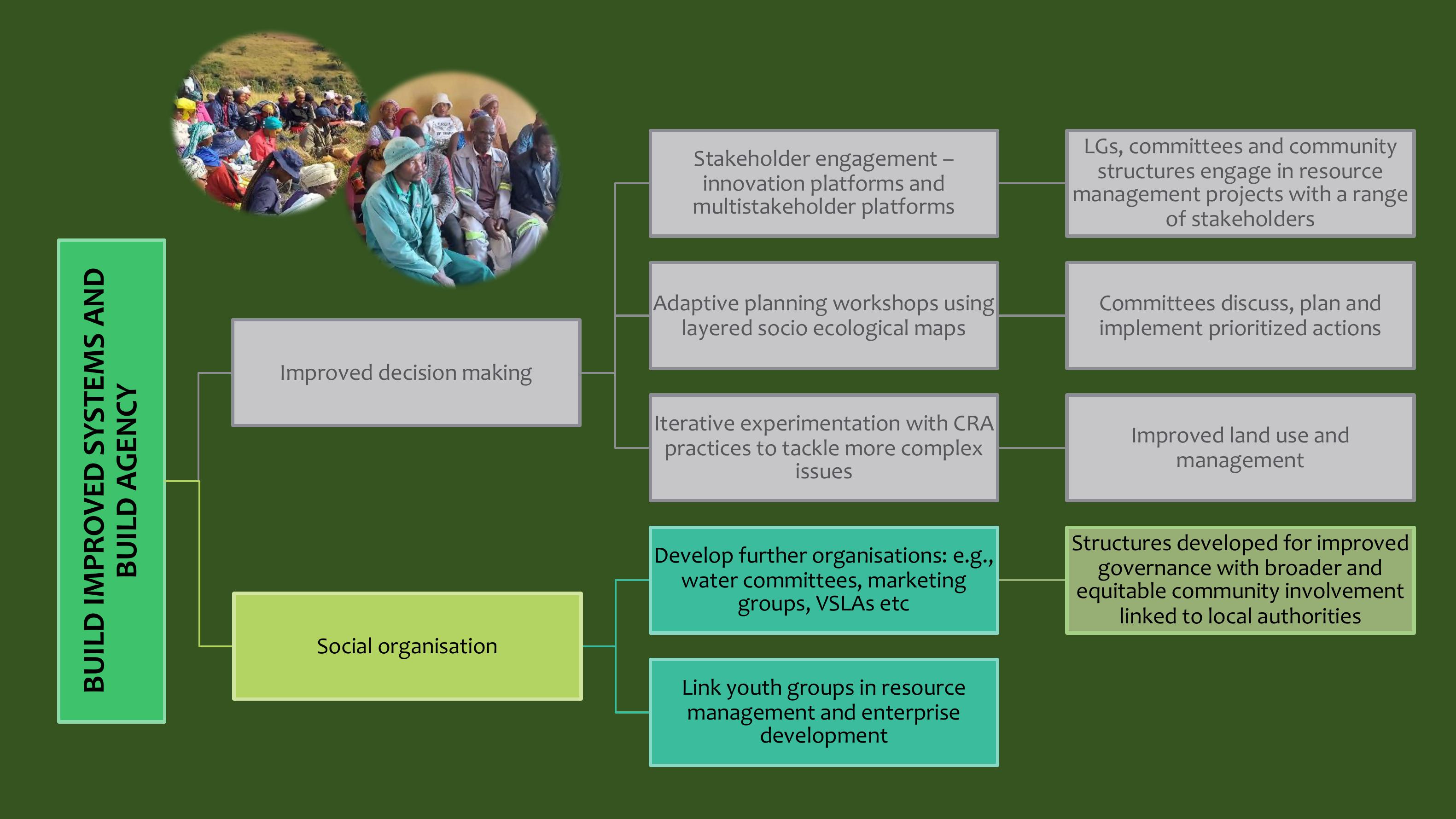
BUILD IMPROVED SYSTEMS AND
BUILD AGENCY
Improved decision making
Stakeholder engagement –
innovation platforms and
multistakeholder platforms
LGs, committees and community
structures engage in resource
management projects with a range
of stakeholders
Adaptive planning workshops using
layered socio ecological maps
Committees discuss, plan and
implement prioritized actions
Iterative experimentation with CRA
practices to tackle more complex
issues
Improved land use and
management
Social organisation
Develop further organisations: e.g.,
water committees, marketing
groups, VSLAs etc
Structures developed for improved
governance with broader and
equitable community involvement
linked to local authorities
Link youth groups in resource
management and enterprise
development
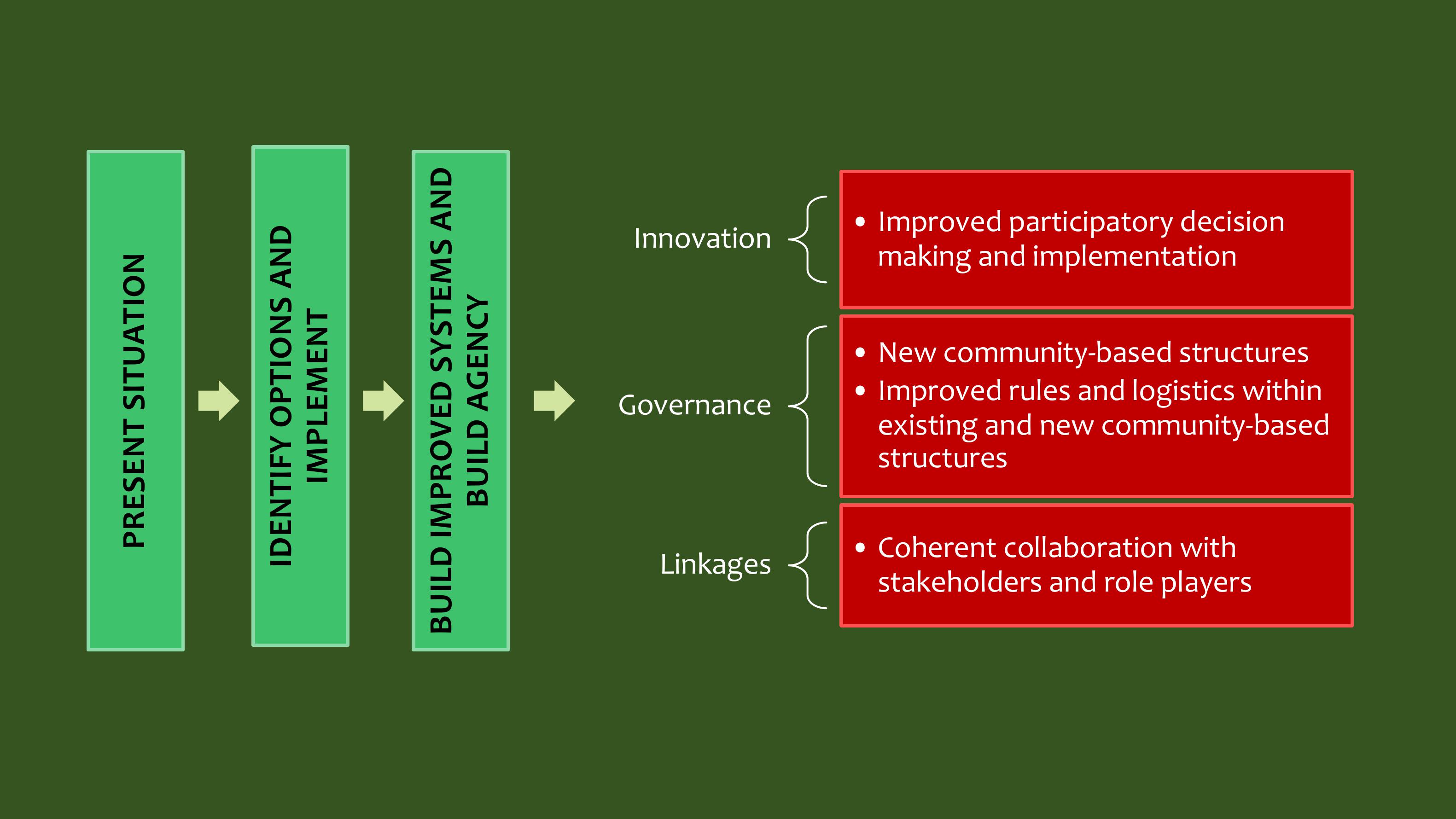
PRESENT SITUATION
IDENTIFY OPTIONS AND
IMPLEMENT
BUILD IMPROVED SYSTEMS AND
BUILD AGENCY
Innovation •Improved participatory decision
making and implementation
Governance
•New community-based structures
•Improved rules and logistics within
existing and new community-based
structures
Linkages •Coherent collaboration with
stakeholders and role players
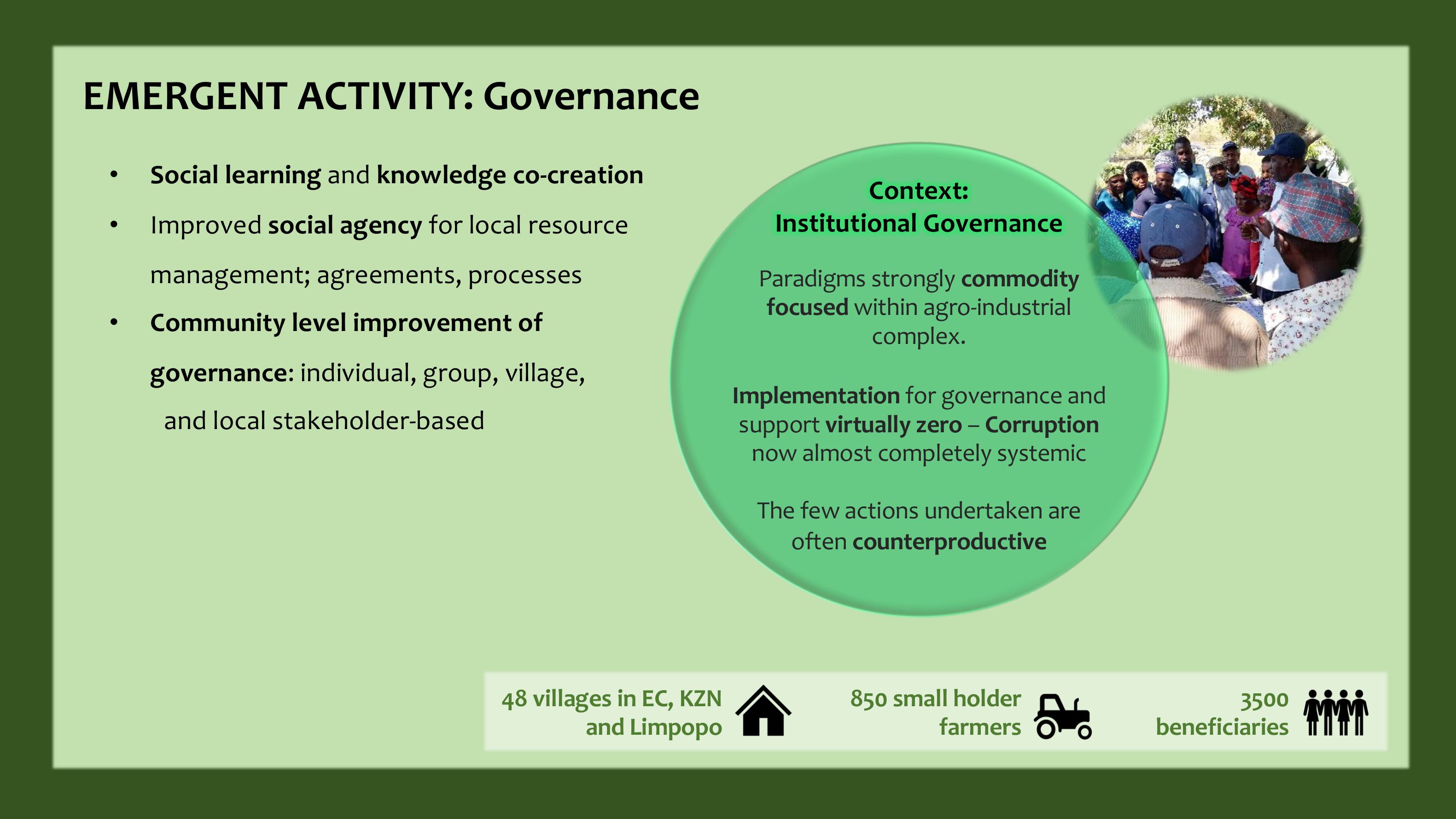
EMERGENT ACTIVITY: Governance
•Social learningand knowledge co-creation
•Improved social agency for local resource
management; agreements, processes
•Community level improvement of
governance: individual, group, village,
and local stakeholder-based
Paradigms strongly commodity
focusedwithin agro-industrial
complex.
Implementationfor governance and
support virtually zero – Corruption
now almost completely systemic
The few actions undertaken are
often counterproductive
Context:
Institutional Governance
48 villages in EC, KZN
and Limpopo
850 small holder
farmers
3500
beneficiaries

Conservation Agriculture

Local farmer centre for input
supply and salesSummer cover cropsWinter cover crop mixDolichos beans CA plot
Strip cropping perennial fodder with short
season maizeMaize and cowpea intercropped plotLate bean planting alongside short season
maize and other CA plots
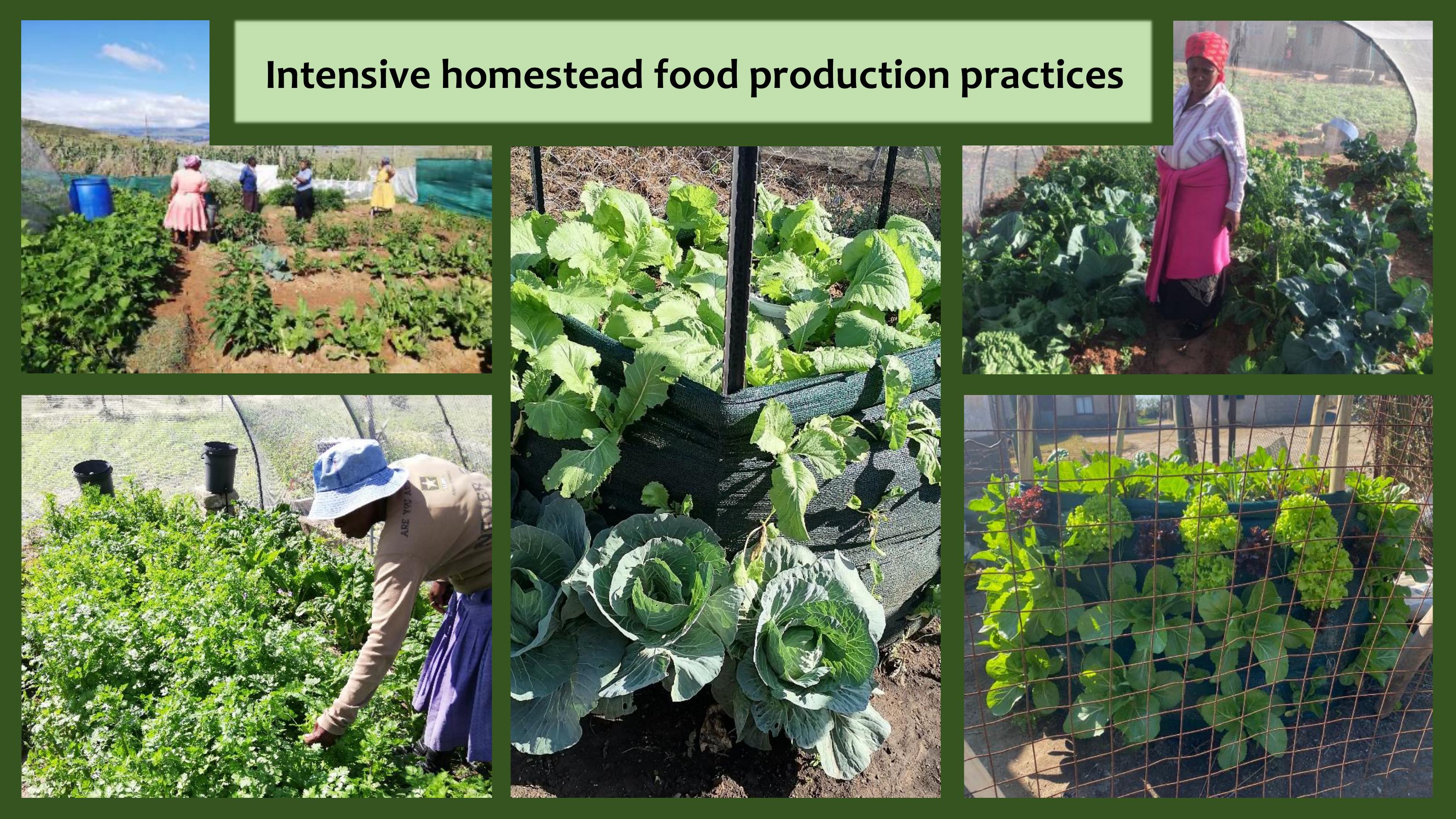
Intensive homestead food production practices

Improved irrigation practices: Irrigation
scheduling (chameleon sensors)Grey water managementNatural pest and disease control
Composting Deep and shallow trench beds
Microclimate management: Shade cloth tunnelsCrop diversification
Mulching
Improved irrigation practices:
Drip irrigation
Mixed cropping

Livestock integration: Fodder production
Sunflowers, Sun
Hemp, milletTurnips Lespedeza Bird resistant
Sorghum TallfescueRadishes, oats
Cover crop options:
•Blocks or strips of SCC mix (fodder sorghum, sun hemp, sunflower), Dolichos and WCC mix (Saia oats, fodder rye, and fodder radish)
•Strips of fodder species, annual(Teff, turnips) and perennial(Lespedeza, Tall Fescue

Livestock integration: Fodder management
Manual baler used at household level
Collection of stover and cutting of veld grass for
baling and grazing, Grazing cover crops or stover in situ
Return of manure to the fields
(carry or in situ)
Use of bales with winter fodder supplements,
e.g. LS 33, premix450, protein blocks

Local water access: Spring protection and boreholes
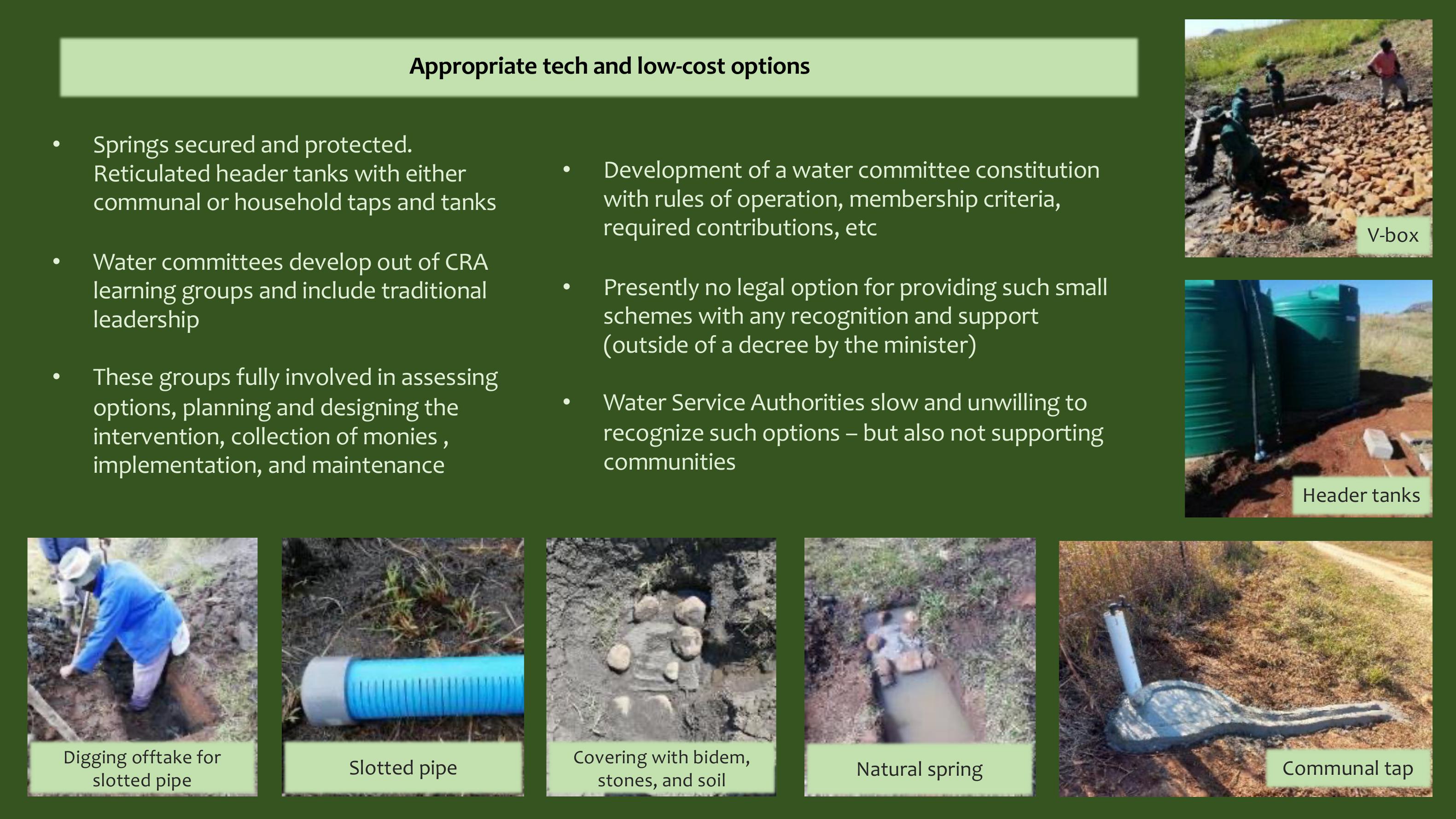
•Developmentof awater committee constitution
with rulesof operation, membership criteria,
required contributions, etc
•Presently no legal option for providing such small
schemes with any recognition and support
(outside of a decree by the minister)
•WaterServiceAuthoritiesslowandunwillingto
recognize such options – but also not supporting
communities
Appropriate tech and low-cost options
•Springssecured and protected.
Reticulated header tanks with either
communal or household taps and tanks
•WatercommitteesdevelopoutofCRA
learning groups andinclude traditional
leadership
•These groups fully involved in assessing
options, planning and designing the
intervention, collectionof monies ,
implementation, and maintenance
V-box
Header tanks
Communal tap
Digging offtake for
slotted pipe
Covering withbidem,
stones, and soil
Slotted pipeNatural spring

•29 VLSAs, 535 participants
•Combined monetary value of over R1 million
•Savings and small loans used for consumption
smoothing, debt repayments, ceremonies, food, home
improvements, small businesses and farming
•VSLAs are crucial for continued involvement in
farming and for more sustainable livelihoods
.
Village Saving and Loan Associations (VSLAs)~R255/
farmer/
month
saved
New innovation: Bulk
Loan Funds - larger
savings and longer
term for greater loan
potential – specifically
for production

.
Local marketing options (appropriate for smallholder farmers)
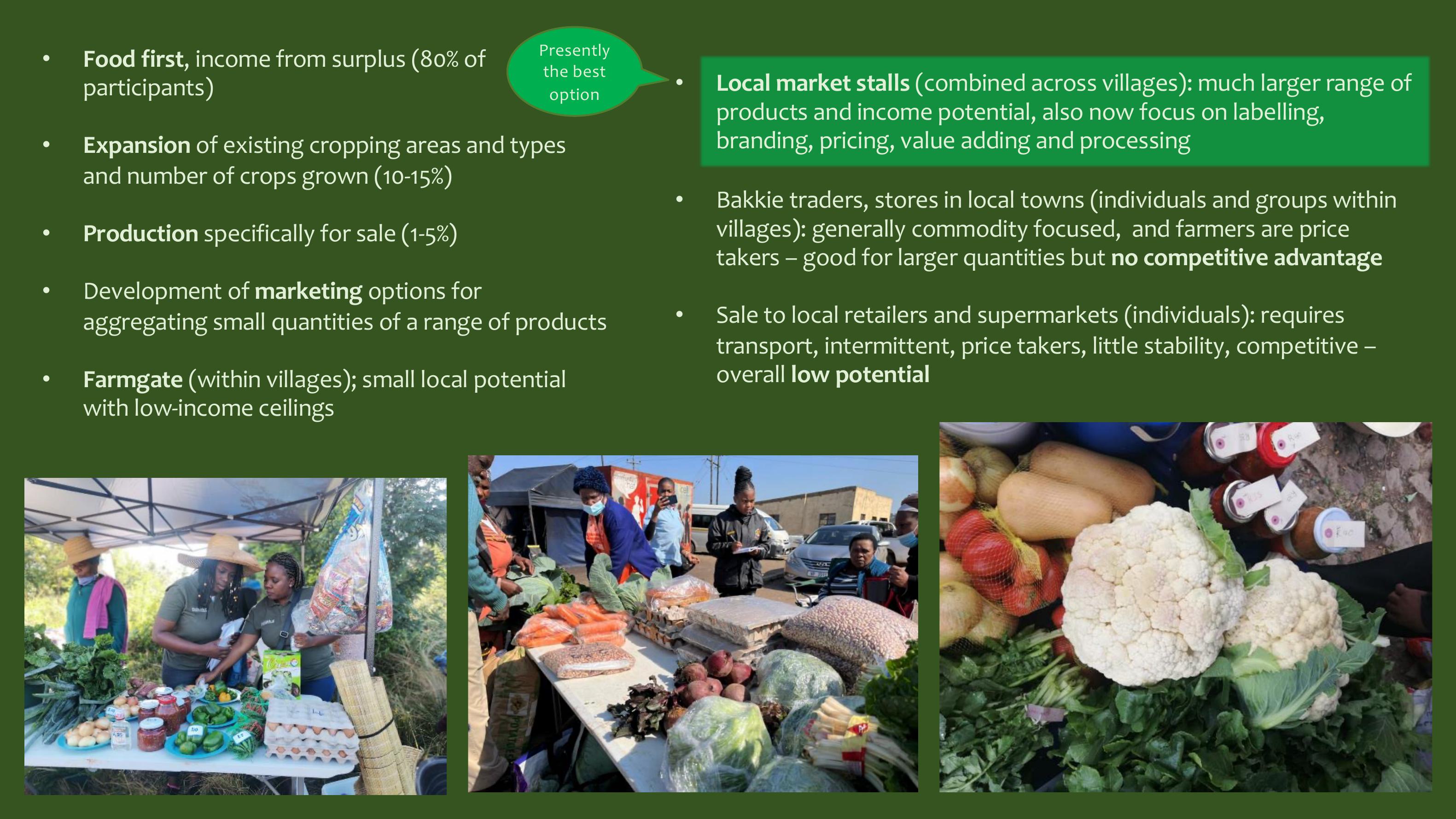
•Local market stalls (combined across villages): much larger range of
products and income potential, also now focus on labelling,
branding, pricing, value adding and processing
•Bakkie traders, stores in local towns (individuals and groups within
villages): generally commodity focused, and farmers are price
takers – good for larger quantities butno competitive advantage
•Sale to local retailers and supermarkets (individuals): requires
transport, intermittent, price takers, little stability, competitive –
overall low potential
•Food first, income from surplus (80% of
participants)
•Expansionof existing cropping areas and types
and number of crops grown (10-15%)
•Productionspecifically for sale (1-5%)
•Developmentofmarketingoptions for
aggregating small quantities of a range of products
•Farmgate(within villages); small local potential
with low-income ceilings
Presently
the best
option
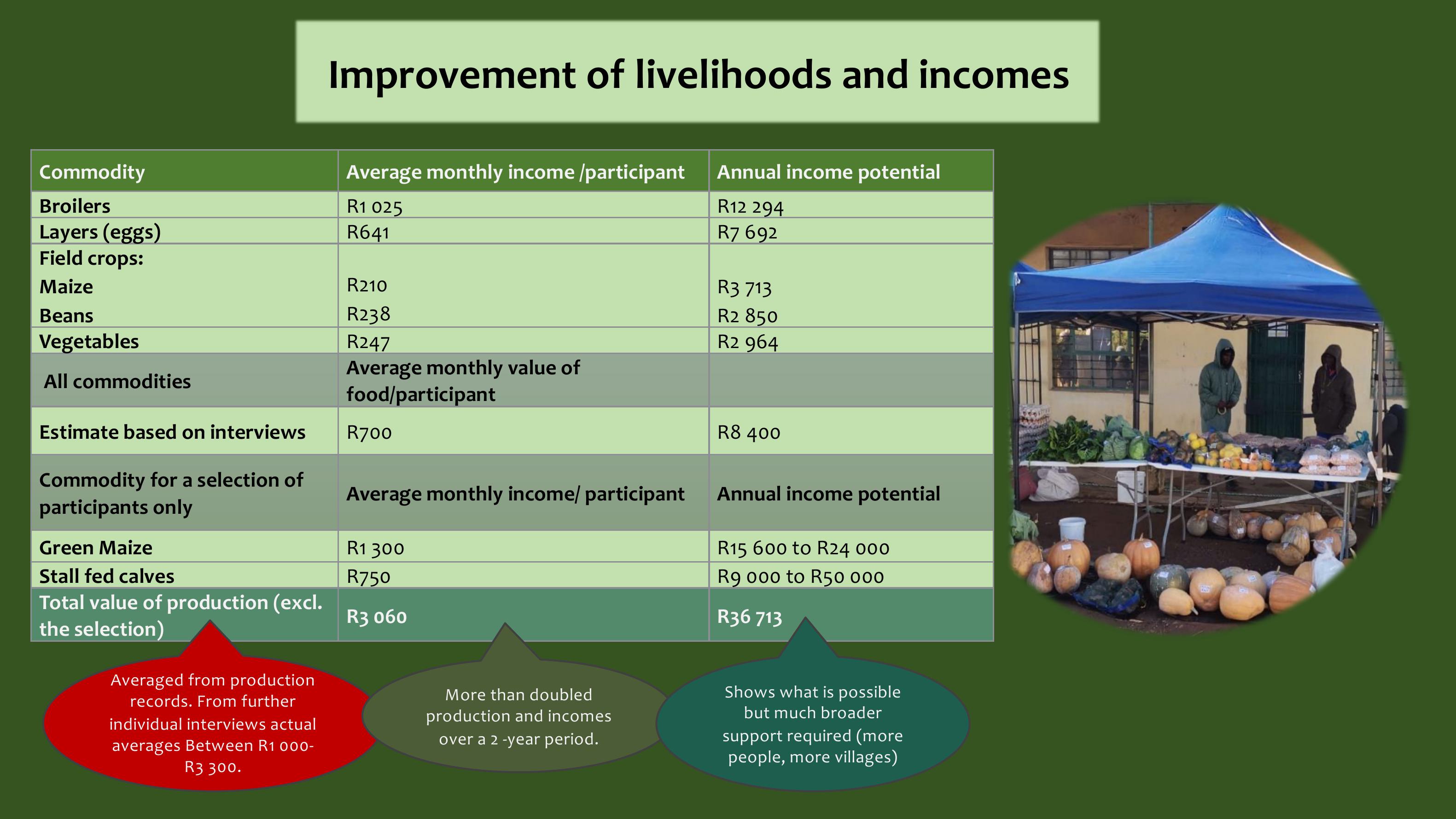
.
Commodity
Average monthly income /participant
Annual income potential
Broilers
R1
025
R12
294
Layers (eggs)
R641
R7
692
Field crops:
Maize
Beans
R210
R238
R3
713
R2
850
Vegetables
R247
R2
964
All commodities
Average monthly value of
food/participant
Estimate based on interviews
R700
R8 400
Commodity for a selection of
participants only
Average monthly income/ participant
Annual income potential
Green Maize
R1
300
R15
600 to R24 000
Stall fed calves
R750
R9
000 to R50 000
Totalvalueofproduction(excl.
the selection)
R3
060
R36
713
Averaged from production
records. From further
individual interviews actual
averages Between R1 000-
R3 300.
More than doubled
production and incomes
over a 2-year period.
Shows what is possible
but much broader
support required (more
people, more villages)
Improvement of livelihoods and incomes
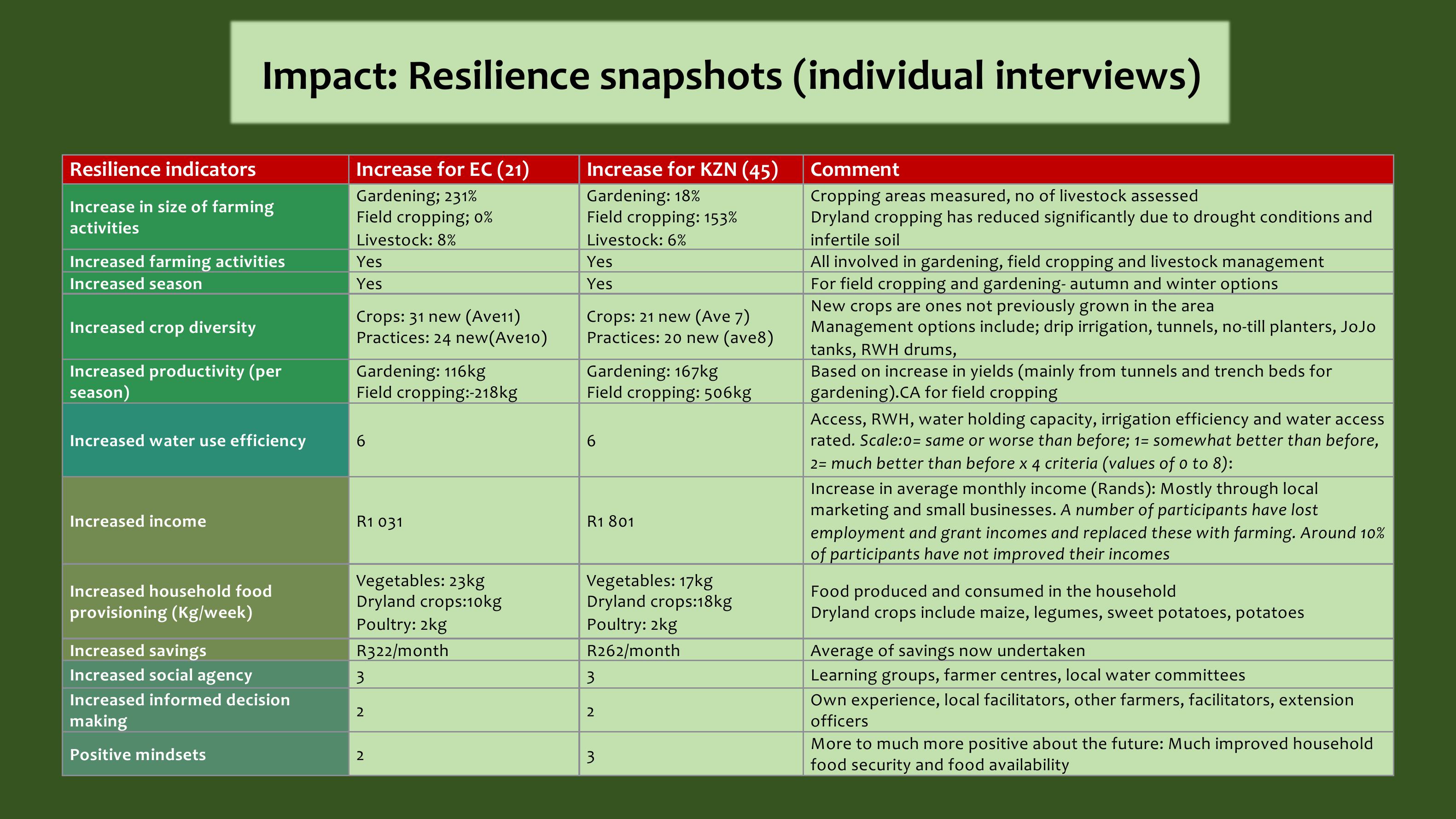
Resilience indicators
Increase for EC (21)
Increase for KZN (45)
Comment
Increase in size of farming
activities
Gardening; 231%
Field cropping; 0%
Livestock: 8%
Gardening: 18%
Field cropping: 153%
Livestock: 6%
Cropping areas measured, no of livestock assessed
Dryland cropping has reduced significantly due to drought conditions and
infertile soil
Increased farming activities
Yes
Yes
All involved in gardening, field cropping and livestock management
Increased season
Yes
Yes
For field cropping and gardening
- autumn and winter options
Increased crop diversity
Crops: 31 new (Ave11)
Practices: 24 new(Ave10)
Crops: 21 new (Ave 7)
Practices: 20 new (ave8)
New crops are ones not previously grown in the area
Management options include;dripirrigation, tunnels,no
-till planters, JoJo
tanks, RWH drums,
Increased productivity (per
season)
Gardening: 116kg
Field cropping:
-218kg
Gardening: 167kg
Field cropping: 506kg
Based on increase in yields (mainly from tunnels and trench beds for
gardening).CA for field cropping
Increased water use efficiency
6
6
Access, RWH, water holding capacity, irrigation efficiency and water access
rated. Scale:0= same or worse than before; 1= somewhat better than before,
2= much better than before x 4 criteria (values of 0 to 8)
:
Increased income
R1 031
R1 801
Increase in average monthly income (Rands): Mostly through local
marketing and small businesses.
A number of participants have lost
employment and grant incomes and replaced these with farming. Around 10%
of participants have not improved their incomes
Increased household food
provisioning (Kg/week)
Vegetables: 23kg
Dryland crops:10kg
Poultry: 2kg
Vegetables: 17kg
Dryland crops:18kg
Poultry: 2kg
Food produced and consumed in the household
Dryland crops include maize, legumes, sweet potatoes, potatoes
Increased savings
R322/month
R262/month
Average of savings now undertaken
Increased social agency
3
3
Learning groups, farmer centres, local water committees
Increased informed decision
making
2
2
Own experience, local facilitators, other farmers, facilitators, extension
officers
Positive mindsets
2
3
More to much more positiveabout the future: Muchimproved household
food security and food availability
Impact: Resilience snapshots (individual interviews)